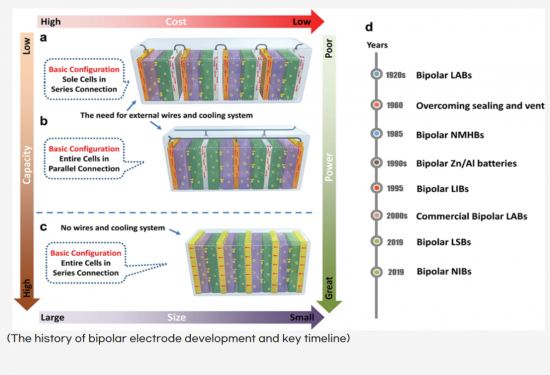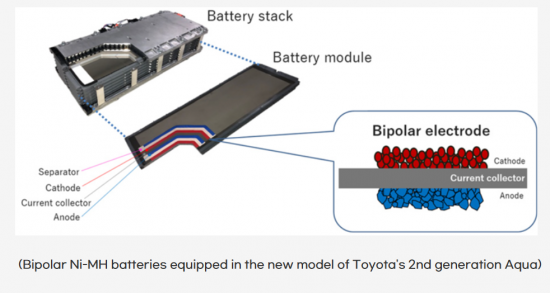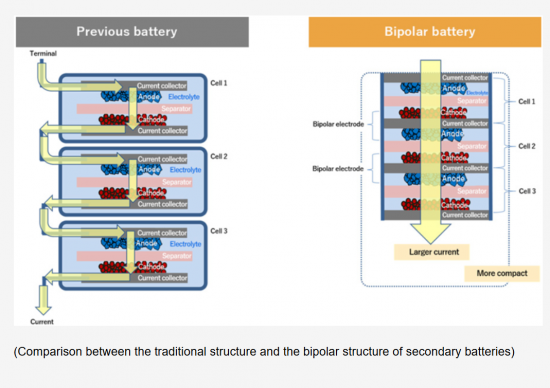PUBLISHER: SNE Research | PRODUCT CODE: 1458501

PUBLISHER: SNE Research | PRODUCT CODE: 1458501
<2024> Current Status and Future Outlook of Bipolar Battery Technology Development
A single-cell secondary battery consisted of monopolar electrodes, where both sides of the current collector are composed of the same electrode material, has all electrodes immersed in the same electrolyte. Since each electrode is connected in parallel using external connecting wires, a significant amount of inactive material has been integrated into the battery system. As a result, it is estimated that the volumetric energy density may experience a loss of approximately 40%, and the gravimetric energy density approximately 20%.
The bipolar battery features a simple cell configuration and shape as it does not utilize electrical connectors or other accessories. The volume of the battery is close to the product of the total stack thickness of the individual unit cells and the substrate area of the unit cell, while the weight of the battery is comparable to the total mass of all components. Although the capacity of the bipolar battery is equivalent to that of a single unit cell, the output voltage of the bipolar battery is determined by the number of unit cells connected in series and the voltage of each cell multiplied together.
Using bipolar electrodes in batteries significantly increases both volumetric and gravimetric energy density. Additionally, based on application-centric design, the battery shape can be easily adjusted to maximize the utilization of the battery storage space in the target device. In other words, the battery volume decreases, and by minimizing the BMS, energy density enhancement and cost savings can be simultaneously pursued through minimized use of cell packaging materials. This ultimately translates into the ability to install more batteries in limited electric vehicle battery mounting spaces, potentially leading to increased driving range. Therefore, these advantages of bipolar electrodes are highly attractive for the design of secondary batteries used in mobile electronic devices and electric vehicles.
Another advantage of bipolar electrodes is that electron flow occurs vertically through the substrate, and when the substrate's cross-sectional area is large, current density and distribution are significantly improved. Therefore, using bipolar electrodes allows fast-operating secondary batteries to function safely without any safety issues.
Starting with Furukawa Electric's compact batteries featuring bipolar electrodes, Toyota has recently commercialized bipolar Ni-MH batteries, which were applied to the Aqua HEV. In the announcement at June 2023, Toyota revealed a roadmap stating that they plan to produce bipolar LFP batteries for volume-grade EVs in 2026-2027 and bipolar Ni-based LIBs for future versions of EVs in 2027-2028. This roadmap aims to enhance driving range and reduce costs compared to performance versions of LIBs.
The recently released Toyota Crown Crossover and Lexus RX feature an improved version of the traditional Ni-MH battery, known as the bipolar Ni-MH. This marks a departure from the previous trend of using LIBs, especially in high-end and fuel-efficient models. This shift suggests an intention to gradually expand the use of Ni-MH batteries across the lineup, indicating a strategic change in battery technology adoption.
In this report, we have compiled the history of the development of bipolar electrodes, which have recently begun to be applied, as well as the current status of research and development. We have detailed each development to provide a comprehensive overview, making it easy to understand the overall situation.
The strong points of this report are as follows:
- 1. ailed coverage of recent technological trends related to bipolar batteries
- 2. ailed coverage of the development history and current status of bipolar battery developers
- 3. centrated coverage of the development status of bipolar batteries at Toyota Motor Corporation
- 4. lysis of bipolar battery's key patent



Table of Contents
1. Bipolar Electrodes for Secondary Batteries
- 1.1. The Necessity of Battery Structure Optimization
- 1.2. Bipolar Electrodes
- 1.3. Development of Bipolar Electrodes
- 1.3.1. History of Bipolar Electrode Development
- 1.3.2. Reduction in Weight, Size, and Cost
- 1.3.3. Improvement in Energy Density/Power Density
- 1.3.4. Requirements and Disadvantages of Bipolar Electrodes
- 1.4. Applications of Bipolar Electrodes
- 1.4.1. Bipolar Lead-Acid Batteries (LAB)
- 1.4.2. Improvement of Bipolar Lead-Acid Batteries
- 1.4.2.1. Surface Modification
- 1.4.2.2. Corrosion Prevention
- 1.4.3. Commercialization of Bipolar Lead-Acid Batteries
- 1.5. Bipolar Alkaline Batteries
- 1.5.1. Bipolar Ni-MH
- 1.5.2. Bipolar Al and Zn Batteries
- 1.6. Bipolar Lithium-Ion Batteries
- 1.7. Bipolar post-LiB(Li-S, Na-ion)
- 1.8. Challenges and Outlook
- 1.8.1. Substrate Materials
- 1.8.2. Electrode Materials
- 1.8.3. Electrolyte Materials
- 1.8.4. Engineering Technologies
- 1.8.5. Outlook of Bipolar Electrode
- 1.8.6. Hurdles to Commercialization
- 1.8.7. Other Bipolar Batteries
- 1.8.8. Bipolar Solid-State Batteries
2. Bipolar Solid-State Batteries: Design, Fabrication, and Electrochemistry
- 2.1. Overview
- 2.1.1. Advantages of Bipolar Solid-State Batteries
- 2.1.2. Technical Challenges of Bipolar Batteries
- 2.1.3. Requirements for Bipolar Materials
- 2.2. Bipolar Plates
- 2.3. Fabrication and Electrochemical Characteristics of Bipolar Solid-State Batteries
- 2.3.1. Free standing Lamination Bipolar Solid-State Batteries
- 2.3.2. Printing Bipolar Solid-State Batteries
- 2.4. Results and Future Outlook
3. Bipolar Solid-State Batteries: Design of Energy Density
- 3.1. Overview
- 3.2. Results and Discussion
- 3.2.1. SolidPAC demo
- 3.2.2. Comparison of Bipolar Stacking and Conventional Stacking
- 3.2.3. Sensitivity Analysis
- 3.2.4. Experimental Data Analysis
4. Bipolar Solid-State Batteries: Based on Quasi-Solid Electrolytes
- 4.1. Quasi-Solid Li-Glyme complex
- 4.2. Evaluation of Bipolar Solid-State LIBs
- 4.3. SEM Analysis of Bipolar Solid-State LIBs
- 4.4. Conclusion
5. Bipolar Solid-State Batteries: Based on Sulfide Electrolytes
- 5.1. Overview
- 5.2. Results and Discussion
- 5.2.1. Manufacturing and Characteristics of Cathode Layers
- 5.2.2. Manufacturing and Characteristics of Anode Layers
- 5.2.3. Manufacturing and Characteristics of Mono cells
- 5.2.4. Characteristics of Bipolar Stacked Solid-State Batteries
- 5.2.5. Comparison of Energy Densities in Bipolar Solid-State Batteries
- 5.3. Conclusion
6. Bipolar Solid-State Batteries: Based on Multistage Printing Manufacturing
- 6.1. Overview
- 6.2. Introduction
- 6.3. Experiment
- 6.3.1. Manufacturing of SWCNT-Coated Electrode Active Material
- 6.3.2. Fabrication of Printed Bipolar LIB
- 6.4. Results and Discussion
- 6.4.1. Solid Gel Composite Electrolyte(GCE)
- 6.4.2. Fabrication and Characteristics of Printed Electrodes
- 6.4.3. GCE and Electrode Paste Control
- 6.4.4. Mechanical Flexibility and Thermal Stability
- 6.5. Conclusion
7. Bipolar Solid-State Batteries: Application of FeOx-LFBO Anode
- 7.1. Overview
- 7.2. Introduction
- 7.3. Experiment Results
- 7.3.1. Synthesis and Characteristics of FeOx-LFBO
- 7.3.2. Electrochemical Performance of FeOx-LFBO Anode
- 7.3.3. Mechanism Analysis
- 7.3.4. Electrochemical Performance of Cu-free LIB
- 7.4. Conclusion
8. Bipolar LFP/LTO Batteries: LIBs for Micro/Mild Hybrid
- 8.1. Overview
- 8.2. Introduction
- 8.3. Experiments
- 8.4. Results and Discussion
- 8.4.1. LFP, LTO
- 8.4.2. 15Wh Bipolar Battery
- 8.4.3. Safety
- 8.5. Conclusion
9. Bipolar Ni-MH Batteries
- 9.1. Overview
- 9.2. Battery Design
- 9.3. Application of Wafer Cells
- 9.4. Application in HEVs
- 9.5. Application in PHEVs
- 9.6. Application in Utility
- 9.6.1. High-Power Bipolar Batteries
- 9.6.2. High-Energy Bipolar Batteries
10. Bipolar High-Voltage Na-ion Batteries
- 10.1. Overview
- 10.2. Introduction
- 10.2.1. Monopolar 48V Battery System
- 10.2.2. Commercialization Issues of Bipolar Batteries
- 10.3. Experiment and Method
- 10.4. Results
- 10.4.1. Bipolar Batteries with Liquid Electrolytes
- 10.4.2. nS mP(Series-Parallel) Bipolar Batteries
- 10.4.3. Na-ion Bipolar Batteries with Above 5V
- 10.4.4. Custom Cell Voltage Profile Design
11. Bipolar All Polymer Batteries
- 11.1. Characteristics of All Polymer Batteries
- 11.1.1. Advantages of All Polymer Batteries
- 11.1.2. Disadvantages of All Polymer Batteries
- 11.1.3. Energy Density of All Polymer Batteries
- 11.1.4. Manufacturers of All Polymer Batteries
- 11.1.4.1. Kawasaki Heavy Industries
- 11.1.4.2. JFE Chemical
- 11.1.4.3. Teijin
- 11.1.4.4. Gunze/Sanyo Chemical Industries
- 11.2. Manufacturing Methods of All Polymer Batteries
- 11.3. Characteristics of All Polymer Batteries
- 11.3.1. Voltage Increase by Stacking
- 11.3.2. Elimination of Drying Process
- 11.3.3. Improve of Production Speed
- 11.4. Basic Structure of All Polymer Batteries
- 11.5. All Polymer Batteries Stacked in Series
- 11.6. Safety-Enhanced Bipolar All Polymer Batteries
- 11.7. Core-Shell Type Electrode Materials
- 11.8. Bipolar All Polymer Batteries by APB Corporation
- 11.9. Future Outlook of All Polymer Batteries
12. Bipolar Lead-Acid Batteries (Furukawa Electric Co., Ltd.)
- 12.1. World's First Commercialization
- 12.1.1. Structure and Challenges of Bipolar Lead-Acid Batteries
- 12.1.2. Overcoming Challenges with Metal/Polymer Materials
- 12.2. ESS Batteries for Long-Term Power Storage
13. Bipolar LIBs (Fraunhofer IKTS)
- 13.1. Overview
- 13.2. Concept of Bipolar Batteries
- 13.3. Wet Process Electrode Manufacturing
- 13.4. Separator Coating
- 13.5. Bipolar Cells and Stacks
- 13.6. Roll Clad Foil for Bipolar Battery (SCHLENK)
14. Bipolar Ni-MH Batteries (TOYOTA)
- 14.1. Characteristics of Bipolar Batteries
- 14.2. New Battery Technologies
- 14.3. Battery Innovation by TOYOTA
- 14.4. Timeline of TOYOTA
- 14.5. Manufacturing Process by TOYOTA
15. Bipolar Battery Patents
- 15.1. TOYOTA: Bipolar Ni-MH Batteries
- 15.2. Hyundai Motor Company: Bipolar Solid-State Batteries
- 15.3. TOYOTA: Bipolar Solid-State Batteries
- 15.4. Samsung SDI: Bipolar Electrodes and Manufacturing
- 15.5. LG Chem: Bipolar Batteries
- 15.6. LGES: Bipolar LIBs
- 15.7. KITECH: Bipolar Solid-State Batteries
- 15.8. ProLogium: Horizontal Composite Electric Supply Structure
References




